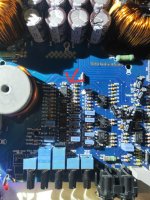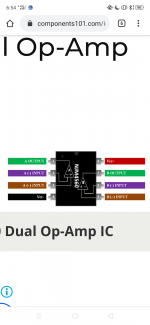It's a ferrite bead. It's a piece of wire through a ceramic ferrite cylinder. 0 ohms is right.
OK cool just thought I'd check. Seems the bass boost has some relation to it.
No audio with no pot has me a bit worried.
The pot was cracked on the underside though so it was definitely faulty.
It may have taken more components out when in failed. Hence no audio 🙄
New pots will be about 2 weeks away
You won't have sound with that out. It is an integral part of the pre-amp circuit.
OH OK like I said I don't know much about the pre amp section.
Well that gives me a little hope that the new pot may fix the problem. Fingers crossed.
The Amp still goes into protect when u cycle between Master and slave and a loud pop through the speaker. This may be normal I'm not sure. But when it was in slave mode turning the bass boost would not cause protect so its definitely a problem in the pre amp section
So it's not normal to go into protect when u cycle between Master and slave. Just tried it on the other amp and no pop or protect on that one
Does anyone know a way to test these 4560d chips in circuit? Is there a specific voltage that should be on pins?
I notice there should be input voltage on pins 4 and 8.
I notice there should be input voltage on pins 4 and 8.
Attachments
Last edited:
For the most part, except for the power supply pins, the voltage should be very near 0v if the power supply pins have a split supply (±15v).
In the manuals for some amps, they tell you to turn the amp off because there is a risk of popping when making changes but it's rare nowadays. A loud pop is generally due to a defective op-amp with excessive DC on it's output terminal.
In the manuals for some amps, they tell you to turn the amp off because there is a risk of popping when making changes but it's rare nowadays. A loud pop is generally due to a defective op-amp with excessive DC on it's output terminal.
For the most part, except for the power supply pins, the voltage should be very near 0v if the power supply pins have a split supply (±15v).
In the manuals for some amps, they tell you to turn the amp off because there is a risk of popping when making changes but it's rare nowadays. A loud pop is generally due to a defective op-amp with excessive DC on it's output terminal.
Yeah I'm getting a good 23v DC across all the Power pins. I just wanted to see if they could have been part of the issue.
Aside from that. Could it be a bad capacitor in the pre amp section that somehow filters out DC voltage?
What was the greatest DC voltage on the output pins of the various op-amps?
Highest was 22.5vDC and that was on both a and b outputs of this 4560d.
All the rest were 11.5v and 1.2v
Attachments
That's doesn't seem right. Was the black probe on ground?
Yes was on the ground pin of the chip
The IC has no ground pin.
Vcc-?
Attachments
For most all audio circuits, the op-amps are operated from a ±15v supply. The negative supply terminals are connected to the negative 15v supply. Not to ground.
For most all audio circuits, the op-amps are operated from a ±15v supply. The negative supply terminals are connected to the negative 15v supply. Not to ground.
OK so where should I put the black probe if not on the vcc-pin?
Oh sorry I think I understand now. Connect black probe to ground?
Last edited:
10.7vDC is what I get. But most the IC chips are not putting out anything.
I got 10.7v on both a and b of the top chip I posted a photo of earlier
The one below that is 6v and nothing.
Below that 10.7v and nothing
Below 10.7 and nothing
1.3v on b output and nothing on a to the one to the right.
Then from there. Nothing
I got 10.7v on both a and b of the top chip I posted a photo of earlier
The one below that is 6v and nothing.
Below that 10.7v and nothing
Below 10.7 and nothing
1.3v on b output and nothing on a to the one to the right.
Then from there. Nothing
With the black on the ground terminal, what's the DC voltage on the RCA shields?
2mV
None of the op-amps should have any more than about 25mv. There's no exact number but a volt or more for any op-amp in use (sometimes only half of the op-amp is used) is likely indicative or a problem. To know if an op-amp is defective, you have to look at the voltage on the op-amp input terminals and see if the output is what it should be for the two input voltages.
The following page will help you to understand op-amps:
Operational Amplifiers
The following page will help you to understand op-amps:
Operational Amplifiers
- Home
- General Interest
- Car Audio
- Class d amp repair help.


